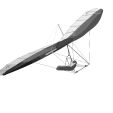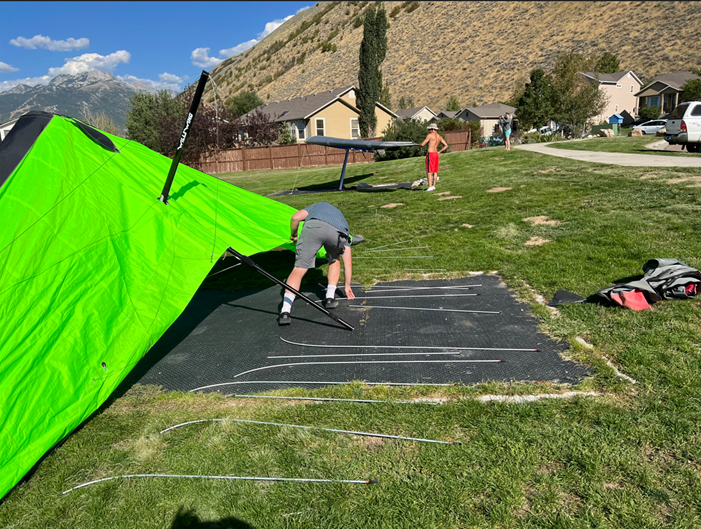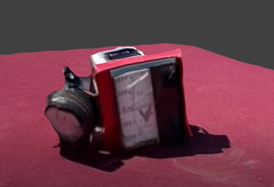Making realistic Hang Glider models
One very important goal of THGF is to build not only accurate Hang Gliding flight models, but to make the gliders themselves be as realistic as possible. As we are planning on doing most of our flying adventures in 3D/VR we want to be able to walk around the glider when on the ground and be able to look at glider details. There is not much detail to see while flying: You see the control bar, the wires, your instruments, but not much of the actual glider. When we film our flights, we can have a unique perspective as we move the camera around. These action shots will be enhanced by having highly detailed models and textures making for more visually impressive videos. Pristine and pure models do not exist in the real world!
Ok, how do we do that?
We will start by scanning real equipment and then bringing those scans into 3D software tools to build our add to our models. We will also be building our models by hand as well. These will need to have textures applied to change them from wire frames to something that look real. This article describes some of our work on both techniques. We are only beginning. We will be updating our progress as we go.
Scans
We did lots of scans on Gliders, equipment, varios, and various types of control bar setups and sailcloth types. We scanned: 1 WW Alpha (trainer), 2 WW Sport 3, and 1 WW T2C performance glider.
Scanning gliders in the open sunlight proved to be quite challenging. The LIDAR scanner prefers a more muted light source to get good scans. Some of the control bar scans worked well but none of the sail or full glider scans were successful. Both the sunlight and wind movement made accurate scans almost impossible. In addition to that, single surfaces such as cloth, are very difficult to scan both side of in 1 scan. Also, the size and height of gliders makes it very difficult in getting the entire object scanned from all directions with any accuracy.
We will attempt to import some of our scans into Blender and see what we can salvage. That will come in Part 3. In Part 2 of this series will attempt to scan a glider in more controlled conditions. This will also include us scanning an entire HP-14 sailplane for yet another project!
This video is an example result of an object scan:
The scan shown above can be edited and manipulated into a 3D object that could then be placed anywhere in most simulators.
Textures
Textures will be used to create 3D PBR textures that can be applied to wire frame models or to help build the wire frames. Here are some examples of toexture images taken:

Figure 1 Leading edge fabric and mylar insert

Figure 2 Batten connection on trailing edge

Figure 3 Underside zipper access

Figure 4 Rear cross bar connection
These are only a few of the images we took. And these were only for a handful of different glider types and colors. We will need many more to be able make a wide variety of custom gliders.
Realistic site building
We visited a Hang Gliding site that was sure to be active: Point of the Mountain Utah. They have 2 protected sites that are flown regularly every day. Our intention was to capture some scans and images of both the sites and of the gliders and equipment we saw. We also filmed a lot of videos that we can use in future VR videos and as samples for animations in VR glider models. It is important that we use real images as we go along. Sails are never pristine. Control bars come in many shapes, types, and conditions. Sailcloth can be of many distinct types and colors. This is only a first step of an ongoing effort to build a library of textures and equipment for use in building models.
The South Side
We will start here.

The south side of the point is used primarily for instruction. It provides smooth laminar airflow every morning. It is approximately 300 ft. high with landing options on both the top and bottom of the hill. It is unequaled in the whole world as a place to fine tune your skills or just learn how to fly. This site will be a featured THGF site someday as it will be perfect for new pilots to learn how to control a virtual hang glider. All aspects of the sport (outside of thermalling) can be learned at just this one site. It is truly rare that a single site can be used for everything from learning first day running launches all the way to soaring flight and even acrobatics. Same day. Same site.
Here we got a chance to scan some training gliders and equipment. This includes some lower performance gliders, harnesses, and big training wheels as shown above. We took pictures of everything, from as many angles as possible. We also took a lot of videos and very importantly, sound recordings. These will help us when we create some model animations of glider ground handling that look realistic.
Watch this video to see the launch sequence of a beginner hang gliding pilot at this site. How they go from a tied down glider, hang check, pickup, and then walk to launch. They we see how a beginner take off looks like in a nice, steady breeze.
Site scans
To make this site as realistic as we can to make it as immersive as we can for new pilots, we did a lot of site scans to get some local features to add to the generic photogrammetry provided by the simulator.
Tie down examples: Image and 3D scan.

Figure 5 Rope Tie

Figure 6 Rope Tie 3D Scan
This image shows a typical tie down area just behind the launch. Imagine your VR experience with and without these types of details. These little touches will make an enormous difference in both the look and feel of experiencing a virtual copy of this site.
The simulator will render this exact view, but it will not look just like this. It will be much more generic and incorrect in how it depicts the soil and vegetation. We can use photos and scans to improve that too.

Figure 7 Behind launch. What the pilot sees.
Additional details will also help. If for example, the Windmills west of this site are not automatically generated I am sure we can find a 3rd party tool that can be added!
We will build and maintain scenery libraries that site builders can use objects from when building out details of sites.

Figure 8 Site Windmills
Hang Gliding sites can be quite beautiful, or very drab! Each is vastly different from all the others, and it is in the details that will provide VR immersion or not. Local pilots, real pilots, would dismiss any site out of hand if it did not have some details of the actual site that they know.
Simulators are designed to show detailed airports, runways, taxi ways, lights, service vehicles, ground personal, etc. This makes flying from virtual airports fun! We need that same level of possible detail on hang glider sites and only we (the community) can or will do it.
Flying sites are not airports, so we do not get that kind of support. What we are building as a site would be defined as ‘scenery’ in a simulator. We are providing and adding details at the ground level. Much more to come about this in future articles.
Here is a good example to what this site scenery would need to include:
Campground in the background.
Information building. It has signs and information about the site!
Parking areas. These should have a few flying type vehicles parked about.
Simulator rig. Used in ground training.
Windsock. Not some pristine sock, no sir. That sock has seen some hours.

Figure 9 South Side Parking area
The North Side
Extremely soarable.

The North side of the Point is for racking up hours. It is very soarable in the afternoon when the prevailing wind switches and flows from the Great Salt Lake to the south. Launch is from another 300 ft hill, or bench, and the task is to get high enough to get back to the 1000 ft wall of sand behind the launch. Landing is possible below the bench and on top of the bench for a top landing. This is a state sponsored flying site and therefore protected. (hopefully). The point is populated with many more paragliders than hang gliders by about a factor of 80 to 1. This site can be very busy. I have personally flown here with over 200 gliders in the air at the same time. This site will teach a pilot about low level soaring, soaring at altitude, top landings, flying with others (rules of the road), and perfecting flying skills by quickly building airtime.
Watch this video to see how a veteran Hang Glider pilot with over 50 years of experience takes to the sky. This also shows how different launch techniques can be and that also depends on wind, altitude and type of harness used. Our animations for launch and landing in our glider models should allow some variety too.
Site scans
This site is similar to the south side (they are the same mountain), but also distinctly different. The north side features a paved parking lot and mowed grass setup areas. Paragliders have their areas, the hangies have theirs. Tie downs on the North Side are the nicest of any site I have ever been to. Large rubber mats with fixed ropes makes setup and breakdown chores much nicer.
Tie down examples:

Figure 10 North Side tie down area

Figure 11 North Side parking and signs
For the North Side to be realistic it must include the paved parking and grassy areas. It should also have the details like the signage and setup areas. I would also expect the actual launch to have all the details of this launch as well.
Results
These are good first steps in gathering content as we move into building Microsoft Flight Simulator 2020 assets that we will be sharing once the 40th anniversary edition is released. This version will include gliders and soarable weather!
We will continue to post updates as we progress, so look for other updates after this post!




